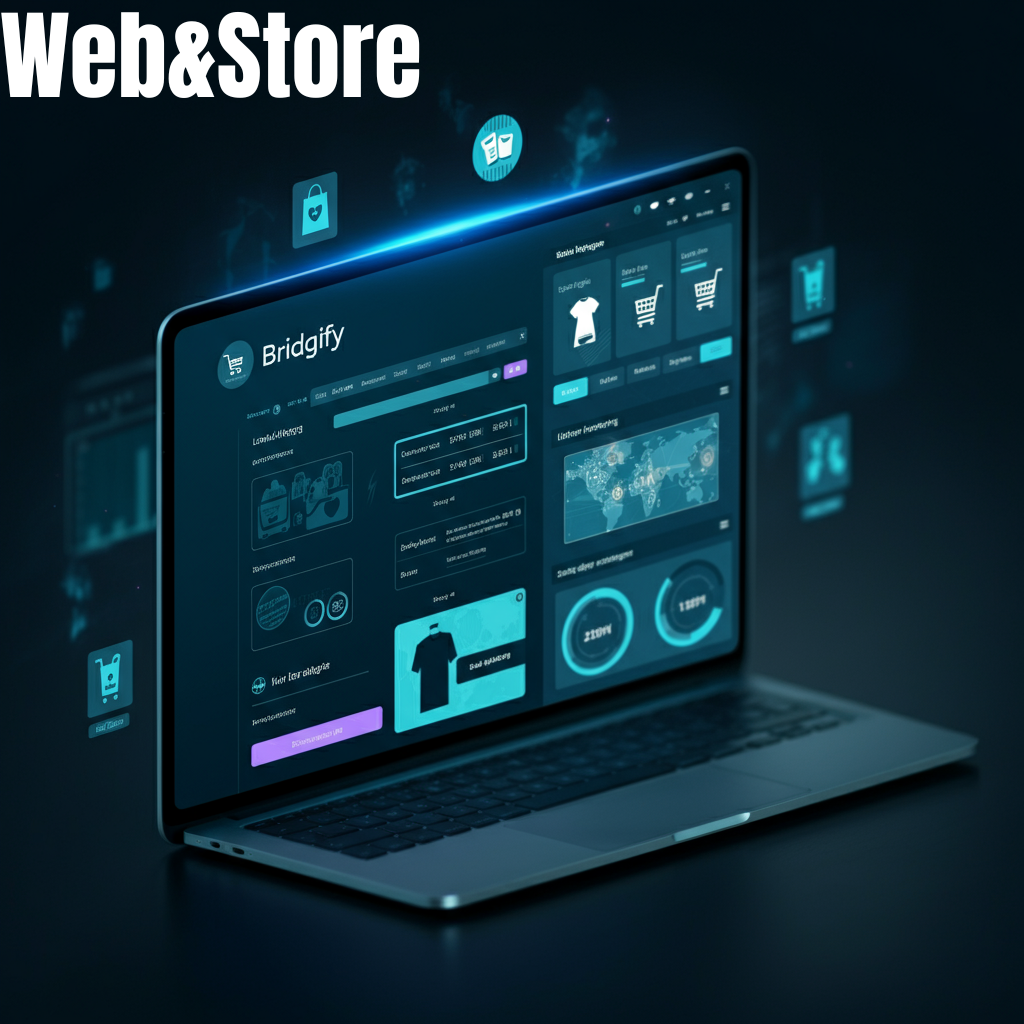In the ever-evolving world of e-commerce, staying ahead of the curve isn’t just a goal it’s a necessity. With global online sales projected to surpass $7.4 trillion by 2025, businesses must adopt tools that streamline operations, enhance customer experiences, and drive growth. Enter Web&Store platforms, the all-in-one solutions reshaping how companies build, manage, and scale their online presence.
But what exactly are Web&Store platforms, and why are they critical for modern e-commerce success? In this comprehensive guide, we’ll explore their evolution, dissect their game-changing features, and reveal how they empower businesses to thrive in a competitive digital landscape. Whether you’re a startup founder or a seasoned entrepreneur, this deep dive will equip you with actionable insights to transform your online strategy.
What Are Web&Store Platforms? (And Why You Need One)
Web&Store platforms are integrated systems that combine website creation tools with full-scale e-commerce functionality. Unlike traditional setups where businesses use separate tools for web design, inventory management, and sales processing, these platforms unify everything under one roof. Imagine designing a stunning website, launching a product catalog, processing payments, and analyzing customer behavior—all without switching between apps or hiring a developer.
Key Benefits:
- Simplified Workflow: Manage your entire online presence from a single dashboard.
- Cost Savings: Eliminate the need for multiple subscriptions (e.g., separate hosting, CMS, and e-commerce tools).
- Scalability: Grow your business without overhauling your tech stack.
The Evolution of Web&Store Platforms: From Basic Websites to AI-Driven Powerhouses
To appreciate the value of modern Web&Store platforms, let’s rewind to their origins and trace their transformative journey.
1. The 1990s: Static Websites – Digital Brochures
The internet’s early days featured static HTML websites that acted as digital brochures. Businesses could list products or services but lacked tools for transactions or user interaction. Updating content required manual coding, making it impractical for non-technical users.
2. The 2000s: Shopping Carts – The Dawn of Online Sales
The rise of platforms like osCommerce introduced basic shopping cart systems, enabling transactions. However, businesses still needed separate tools for website design, payment gateways, and inventory tracking, leading to fragmented workflows.
3. The 2010s: Integrated Platforms – A Game-Changer
The launch of Shopify (2006) and WooCommerce (2011) revolutionized e-commerce by merging website builders with e-commerce tools. For the first time, entrepreneurs could launch a branded online store without coding expertise.
4. Today: AI, Mobile Optimization, and Hyper-Personalization
Modern Web&Store platforms like BigCommerce and Wix eCommerce leverage AI-driven analytics, mobile-first designs, and omnichannel selling to deliver seamless experiences. For example, AI tools analyze browsing patterns to recommend products, while mobile optimization ensures your store looks flawless on smartphones.
7 Must-Have Features of a Modern Web&Store Platform
Not all platforms are created equal. Here’s what to prioritize when choosing a Web&Store solution:
1. Drag-and-Drop Website Builder
A user-friendly interface lets you design professional websites without coding. Look for customizable templates, branding tools, and mobile-responsive designs.
- Example: Shopify’s “Sections” feature allows real-time edits to layouts.
2. Unified Product Catalog Management
Easily upload products, set prices, track inventory, and organize items into categories. Advanced platforms even automate stock updates across multiple sales channels (e.g., Amazon, Instagram).
3. Built-In Payment Processing
Support for PCI-compliant payment gateways (e.g., Stripe, PayPal) ensures secure transactions. Bonus points for platforms offering localized payment options (e.g., Alipay, Klarna).
4. SEO and Marketing Tools
Rank higher on Google with built-in SEO tools like meta tag editors, sitemaps, and blog integrations. Email marketing suites and social media integrations help nurture customer relationships.
5. Analytics and Reporting
Track sales trends, customer behavior, and campaign performance with dashboards. AI-driven insights can predict demand spikes or identify high-value customer segments.
6. AI-Powered Personalization
Platforms like Adobe Commerce use machine learning to:
- Suggest products based on browsing history.
- Automate dynamic pricing.
- Deploy chatbots for 24/7 customer support.
7. Scalability and Third-Party Integrations
Choose platforms that support plugins for accounting (QuickBooks), shipping (ShipStation), or CRM (HubSpot). This flexibility ensures your platform grows with your business.
Why Web&Store Platforms Are Non-Negotiable for E-Commerce Success
Still on the fence? Here’s why adopting a Web&Store platform is no longer optional:
1. Customers Demand Seamless Experiences
A 2023 Baymard Institute study found that 17% of shoppers abandon carts due to complicated checkouts. Web&Store platforms simplify the journey by integrating browsing, purchasing, and post-sale support into one ecosystem.
2. Mobile Shopping Dominates
Over 72% of e-commerce sales occur on mobile devices. Platforms with mobile-optimized designs ensure your store loads quickly and looks polished on smartphones.
3. AI Drives Competitive Advantage
Businesses using AI for personalization report 20% higher conversion rates (McKinsey). Web&Store platforms automate tasks like inventory forecasting, freeing you to focus on strategy.
4. Cost Efficiency
Maintaining separate tools for web hosting (30/month),e−commercesoftware(30/month),e−commercesoftware(50/month), and marketing (29/month**.
Choosing the Right Web&Store Platform: A Step-by-Step Guide
With countless options available, here’s how to pick the perfect fit:
1. Assess Your Business Needs
- Startups: Prioritize affordability and ease of use (e.g., Shopify, Squarespace).
- Mid-Sized Businesses: Opt for scalability and integrations (e.g., BigCommerce, WooCommerce).
- Enterprises: Choose customizable solutions with advanced AI (e.g., Adobe Commerce, Salesforce Commerce Cloud).
2. Test User-Friendliness
Sign up for free trials to evaluate dashboards. Can you upload products or edit designs without tutorials?
3. Check SEO and Marketing Capabilities
Ensure the platform offers:
- Blogging tools for content marketing.
- Schema markup for rich snippets.
- Email campaign builders.
4. Review Customer Support
24/7 support via chat, email, or phone is crucial for resolving issues quickly.
The Future of Web&Store Platforms: AI, AR, and Beyond
The next wave of innovation is already here:
- Augmented Reality (AR): Platforms like WooCommerce AR let customers “try” products virtually (e.g., visualizing furniture in their homes).
- Voice Commerce: Integration with Alexa and Google Assistant enables voice-activated shopping.
- Sustainability Features: Tools to calculate carbon footprints or highlight eco-friendly products align with conscious consumer trends.
Final Thoughts: Embrace the Web&Store Revolution
Web&Store platforms aren’t just tools—they’re the backbone of modern e-commerce. By unifying design, sales, and analytics, they empower businesses to deliver frictionless experiences, reduce costs, and scale efficiently.
Whether you’re launching a side hustle or managing a global brand, adopting a Web&Store platform is your ticket to staying competitive. Ready to transform your online business? Start exploring platforms today, and unlock the full potential of e-commerce innovation.
Bookmark this guide and revisit it as you evaluate platforms. The right choice today will future-proof your business for years to come.



